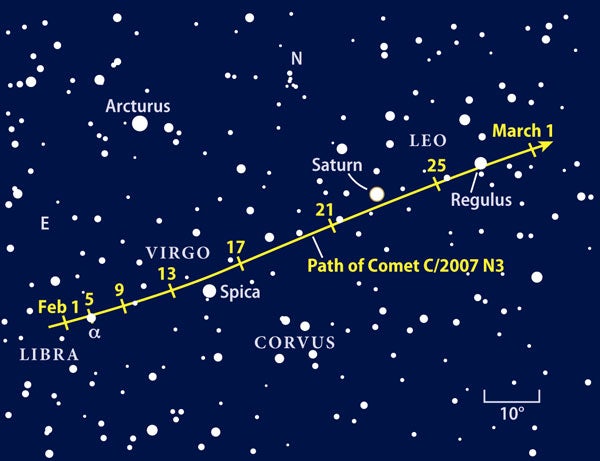
Track asteroid Ceres and Comet Lulin in your sky with StarDome
Astronomy.com’s interactive star chart, StarDome, displays an accurate map of your sky. It’ll help you locate this spectacle. Astronomy magazine subscribers have access to a slew of cool functions with StarDome PLUS.
More resources from Astronomy.com:
- Astronomy news
- Astronomy basics
- Glossary of astronomical terms
- Return to Astronomy “For the media” page
February 18, 2009
WAUKESHA, Wis. — On the evening of February 25, the asteroid 1 Ceres comes closer to Earth than at any time since 1857. To make this occasion even more special, Ceres won’t be this close again for at least another millennium. At closest approach, the asteroid lies 147 million miles (237 million kilometers) from Earth. The long-term gravitational tugs of the planets — particularly massive Jupiter — conspire to modify Ceres’ orbit just enough to allow this month’s record-breaking event.
“Ceres will glow at 7th magnitude on the 25th,” says Astronomy magazine Senior Editor Richard Talcott. “That’s bright enough to show up easily through binoculars.” Skywatchers can find it among the background stars of northern Leo. The asteroid also lies opposite the Sun in our sky that same day, so it rises at sunset and remains visible until dawn. It appears highest in the southern sky around midnight.
Ceres measures 590 miles (950 km) in diameter, about the size of Texas. It holds about one-quarter of the mass in the asteroid belt — the region between the orbits of Mars and Jupiter that contains hundreds of thousands of small rocky bodies. It’s the only asteroid big enough that gravity has pulled it into a spherical shape. Because of this, the International Astronomical Union in 2006 designated Ceres as one of the first three dwarf planets, along with distant Pluto and Eris.
Leo also hosts the current sky’s brightest comet during February’s final week. Comet C/2007 N3 (Lulin) should glow around 5th magnitude in late February. That’s bright enough to glimpse with naked eyes under a dark sky and within easy reach of binoculars from a suburban backyard. At its closest approach to Earth February 24, it lies 38 million miles (61 million km) away. Talcott recommends using the bright planet Saturn as a guide. “On the 23rd, Comet Lulin sits right next to Saturn,” he says. “The ringed planet also lies in Leo, where it shines brighter than any of the Lion’s stars.”
Related blog: Spot and follow the year’s brightest comet with Astronomy.com, by Rich Talcott, Senior Editor
Chinese astronomers Quanzhi Ye and Chi Sheng Lin (members of the Lulin Sky Survey) discovered this comet in July 2007. It appears to be making its first foray into the inner solar system. As the Sun’s light heats the “dirty snowball,” its ices turn to gas. The fuzzy glow we see on Earth comes from sunlight interacting with this liberated gas and dust.









